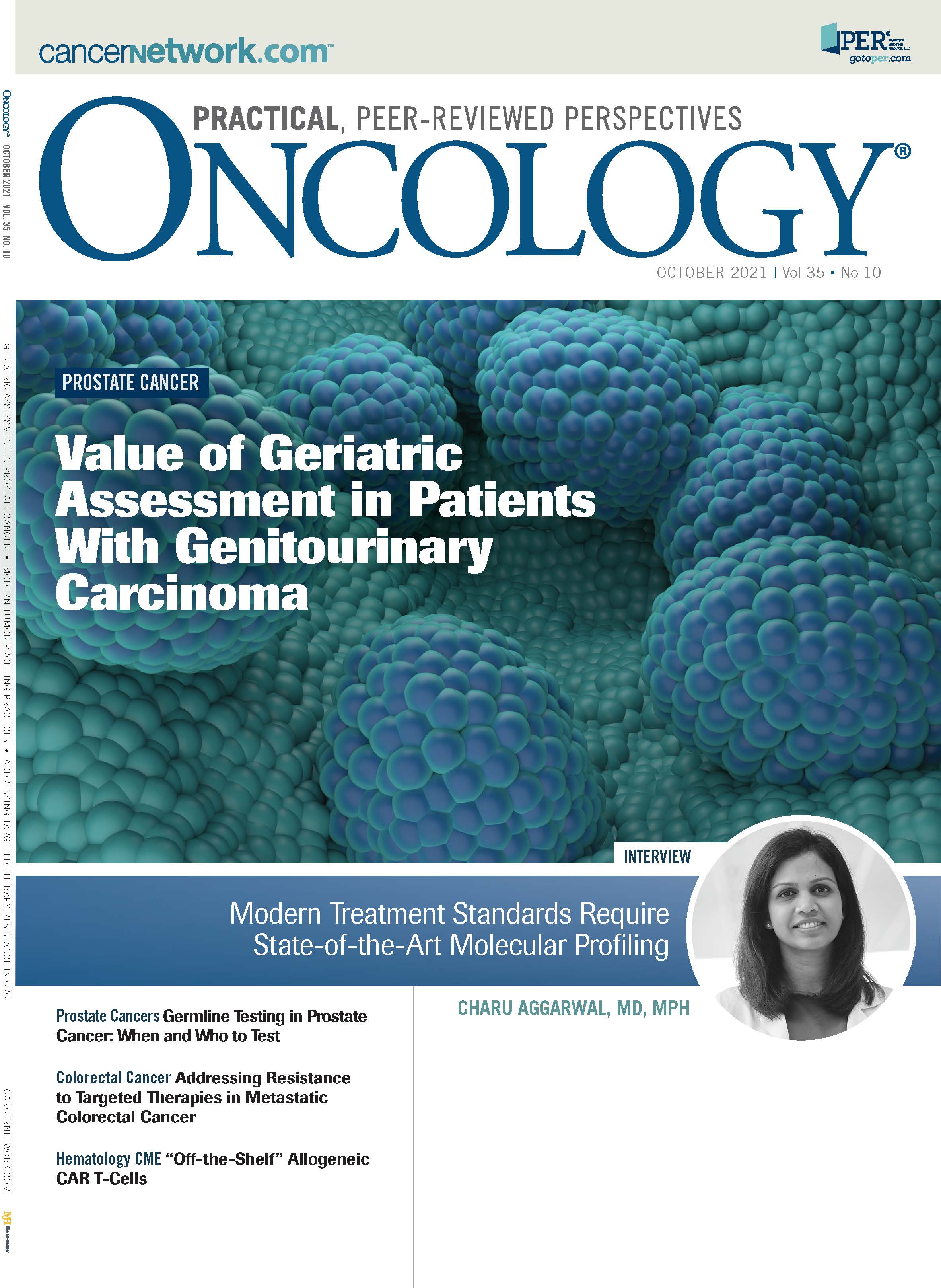Value of Geriatric Assessment in Patients With Genitourinary Carcinoma
This work from Quirin Zangl, MD, and colleagues to evaluate comprehensive geriatric assessment tools to better guide patients with urogenital carcinomas perioperatively and, consequently, to intensify or reduce hospital resource use.
ABSTRACT
Objectives: This work aims to evaluatecomprehensive geriatric assessment (CGA) tools to better guide patients with urogenital carcinomas perioperatively and, consequently, to intensify or reduce hospital resource use.
Methods: After informed consent, 111patients were included, all aged more than 65 years, with oncological surgery (with proof of a malignancy), a Mini Mental State Examination (MMSE) score of at least 23 points, and a prospective life expectancy of more than 2 months. Patients were divided into 2 groups: prostate cancer (n = 88) and distal urinary tract cancer (n = 29). Further CGA tools were Instrumental Activities of Daily Living (iADL), Activities of Daily Living (ADL), and the Charlson Comorbidity Index (CCI). The relationships between CGA and complications, hospital duration, death rate, and baseline characteristics were analyzed.
Results: In comparison with the patients with prostate cancer, those with kidney/distal urinary tract cancer had higher CCI scores (median, 3 vs 2; P <.001), MMSE scores (29 vs 28; P = .031), complication rates (55.2% vs 22.0%; P = .001), and hospital duration (16 vs 10 days; P <.001), as well as more deaths in the group (8 vs 0). Comorbidities (6 vs 2; P <.001), Physical Status Classification System (ASA state [3 vs 2; P <.001]), and median age (74 vs 71 years; P =.008) were all higher in the kidney/distal urinary tract group, and they had fewer problems with postoperative ADL items, which were significantly lower than those of the prostate group (P = .043). Intra- and intergroup comparisons of preoperative and 1-year ADL/iADL values did not differ significantly.
Conclusion: These study results underscore the importance of CGA in patients with genitourinary carcinoma; most patients have high regenerative potential. Patients with kidney/distal urinary tract cancers are older, have more comorbidities, and have more postoperative impairments than patients with prostate cancer.
Oncology (Williston Park). 2021;35(9):620-627.
DOI: 10.46883/ONC.2021.3510.0620
1. Introduction
As life expectancy increases worldwide, so does the incidence of malignant tumors in surgical subspecialties like urology.1 While the surgical treatment of urological cancers is very standardized today,2 protocols that address individual life circumstances are still rare in clinical routine. If a patient already has problems managing the requirements of normal day-to-day life, exacerbated stress reactions due to an operation can undoubtedly worsen this. In contrast, an untreated malignant carcinoma usually causes death; therefore, it is critically important to address individualized perioperative therapy strategies. The expression “patient empowerment” is increasingly gaining clinical acceptance, meaning clinicians may focus on better adjusting treatment strategies individually, detecting patients who are at risk of being over- or undertreated, and possibly improving such outcome parameters as morbidity, mortality, length of hospital stay, and complication rates.3 Due to the increasing number of elderly people with malignant genitourinary carcinomas,comprehensive geriatric assessments (CGA), including the Activities of Daily Living score (ADL), modified by Barthel, and the Instrumental Activities of Daily Living score (iADL), promoted by Lawton and Browdy, are gaining increasing acceptance.4 Additional CGA instruments, like the Mini Mental State Examination (MMSE) and the Charlson Comorbidity Index (CCI), should help detect patients who are at increased risk for worse postoperative outcomes. Additional factors like age, medical comorbidities, psychosocial disorders, specific geriatric conditions, previous health care utilization, and private living situation are integrated into a holistic and therapeutic concept for patients 65 years and older.4 This article uses ADL and iADL as standardized tools to evaluate their efficacy in order to allocate resources properly during urological cancer surgery. The predictive value of ADL and iADL scores in geriatric patients with cancer has been long established.5 To the best of our knowledge, there is no literature around functional status in geriatric patients specific to genitourinary carcinomas. In the work below, we aim to evaluate the aforementioned CGA tools to better guide surgical patients with urogenital carcinomas perioperatively and, consequently, intensify or reduce hospital resource use.
2. Materials and Methods
2.1. Enrollment of patients, data collection, and inclusion and exclusion criteria
This trial is a substudy of the previously published PERATECS3 project (NCT01278537). All patients provided written informed consent for data collection and publication. The Institutional Review Board of the Charité - Universitätsmedizin Berlin approved the study protocol in January 2009 (EA1/241/08). The clinical substudy took place at the Department of Anesthesiology at Ludwig-Maximilians-University Munich. A total of 305 patients in the urologic ward were screened between April 2011 and July 2012, 111 of whom participated in this study (Ethic-Nr: 2011_095_11). All patients fulfilled the inclusion criteria, which included minimum age of 65 years,giving consent and written approval, oncological surgery (with proof of a malignancy), an MMSE score of at least 23 points, and a prospective life expectancy of more than 2 months.
Patients were excluded from the study if any of the following were missing: written informed consent, participation ability, accommodation in an institution on judicial or official order, emergency interventions and ambulant patients, lacking willingness to save and hand out data within the study or ability to understand the German language. Patients were also excluded if they were an employee of one of the study centers; had 2 or more carcinomas; were included in an adjuvant therapy study at some point during PERATECS; or participated in a different clinical study.
2.2. Investigators, time points, and CGA tools
All investigators received training before the onset of the study. ADL examination per Bartel6 and iADL per Lawton and Brody4 were used in this trial. The ADL and iADL examinations took place using a standardized questionnaire at 3 time points: preoperatively; on the eighth day after surgery; and 12 months after hospital discharge (Figure 1). Additional and well-established CGA toolsused in this trialwere the MMSE5 and the CCI4,5 tests.
FIGURE 1. Perioperative Assessment Time Points

Additionally, Nursing Delirium Screening (NuDESC) was used as a clinically accepted standard tool to diagnose delirium. In each case, a 12-month follow-up after hospital discharge was performed. The ADL and iADL surveys were also performed after 1 year. Including the 12-month follow-up, the survey lasted until July 2013.
2.3. Additional clinical and demographic parameters
Age, body mass index (BMI), Physical Status Classification System of the American Society of Anesthesiologists (ASA) state, length of hospital stay, and the number of medications were analyzed, to be further correlated with the CGA results. Other registered perioperative characteristics included histological confirmation of malignancy and perioperative complications (eg, bleeding with hemoglobin levels lower than 2 g/dl, abdominal wound rupture); infections (eg, wound infections, body core temperature >39 °C); NuDESC score >2; cardiopulmonary complications (eg, acute respiratory distress syndrome, atrial fibrillation and other rhythm diseases, dyspnea, pleural effusion); musculoskeletal complications (eg, joint effusions); gastrointestinal complications (eg, meteorism, nausea, emesis, diarrhea, constipation); extraordinary pain (ie, Visual Analogue Scale score >5), and urogenital complications (eg, urinary stasis, urinary tract infections).
2.4. Data collection and statistical analysis
In total, 305 urologic patients were screened, of whom 199 fulfilled the inclusion criteria; subsequently, 17 declined to participate and 9 had histological confirmation of an oncocytoma, which is definitively nonmalignant. Sixty-two patients were lost to follow-up. The remaining 111 patients were subdivided into groups according to their diagnosis: Group 1: prostate cancer; and Group 2: kidney/distal urinary tract cancers (carcinomas of urinary bladder and ureter; Figure 2).
Statistical analysis was performed with SPSS 15.0 (IBM Statistics). After confirmation for normal distribution, continuous data were displayed as mean (SD) and further analyzed with a t test. Without normal distribution, data were presented as the median, 25% and 75% quartile, and further analyzed with the Mann-Whitney U test. Descriptive statistics were used for additional clinical and demographic parameters, including age, BMI, ASA state, length of hospital stay, and the number of medications. For ADL and iADL, which are nonparametrical parameters, differences were observed between the states before the operation, directly after the operation, and 12 months postoperatively. For further ADL and iADL analysis, the Wilcoxon test was used. If 3 or more groups were analyzed, a Kruskal-Wallis test was used. A Spearman correlation test was performed to detect correlations among length of hospital stay, perioperative complications, and mortality. A P value below .05 was considered significant.
FIGURE 2. Study Diagram
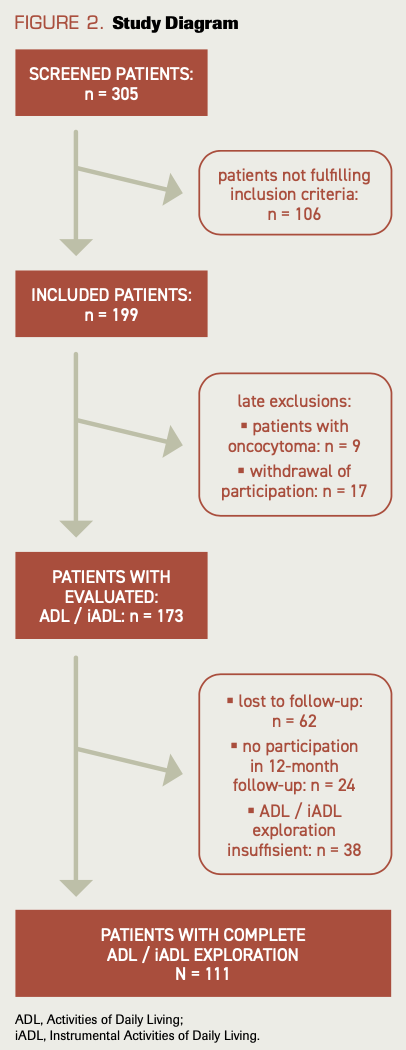
3. Results
3.1. Patient characteristics
Patients with kidney/distal urinary tract carcinoma were older (median age, 71 vs 74 years; P <.008). They also had significantly more comorbidities (median CCI score, 3 vs 2; P < .001), a higher ASA state (3 vs 2; P <.001]), and significantly more preoperative medications (6 vs 2; P <.001). Preoperative MMSE scores were comparable (29 for prostate vs 28 for kidney/distal urinary tract; P = .031) (Table 1).
TABLE 1. Baseline Characteristics
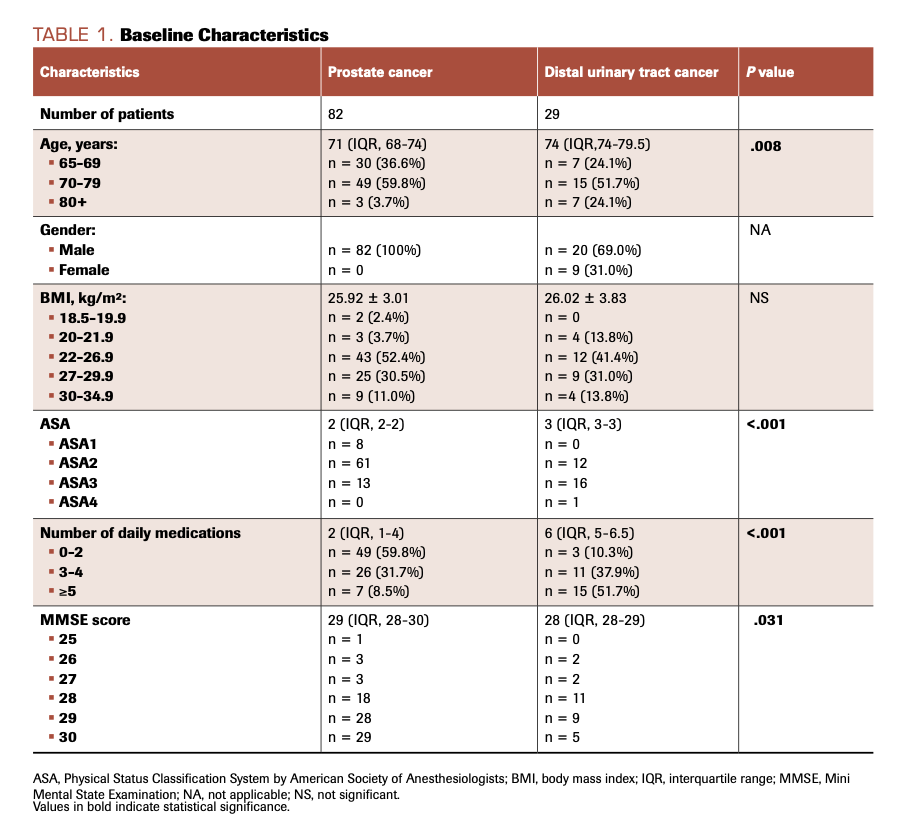
3.2. Daily life activities after the operation and after 1 year
Although both groups reached good levels of daily life activities after 1 year, there were significant differences in daily life activities (both ADL and iADL) directly after the operation and 1 year later. both groups were taken together and statistically evaluated together here (Table 2).
iADL values were comparable in both groups preoperatively and after 1 year. ADL values decreased by 10 points in both groups postoperatively, with a significantly worse performance in the kidney/distal urinary tract group (P = .041). Nevertheless, the intergroup difference of ADL values diminished to a nonsignificant level again one year after surgery (Table 2).
TABLE 2. Intergroup Comparison of Activities of Daily Living.
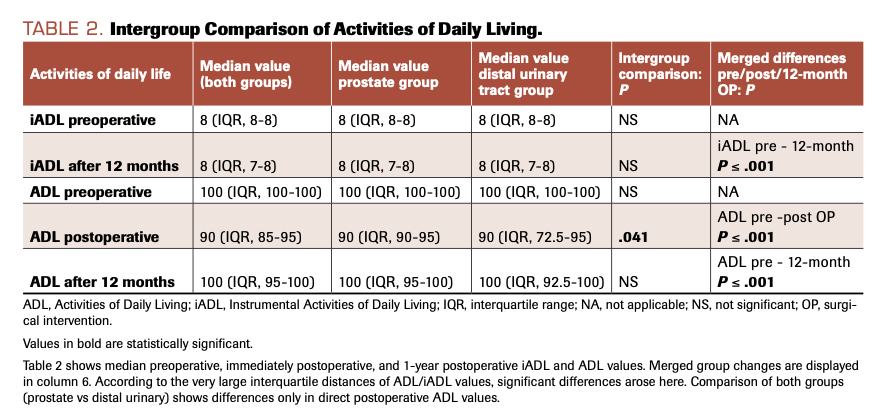
3.3. Correlation of CGA values with outcome parameters
The correlation analysis accounted for both patient groups, and associations among mortality, complication rates, length of hospital stay, and comorbidities were investigated. Before the operations, there was a significant negative correlation between ADL values and mortality (P = .017). A lower ADL value after the operation was associated with longer length of hospital stay (P = 0). All other pre- and postoperative ADL and iADL values did not have significant correlations with relevant outcome parameters (Table 3).
TABLE 3. Correlation of CGA Values With Outcome Parameters
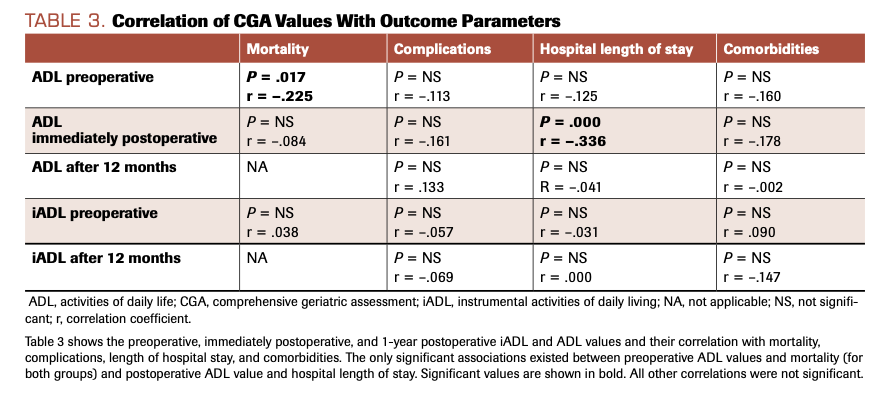
3.4. Correlation of mortality with complication rates, comorbidities, and length
of hospital stay
Eight patients in the kidney/distal urinary tract group died postoperatively, resulting in highly significant associations among perioperative complications (P = .004; r [correlation coefficient] = 0.268), length of hospital stay (P < .001; r = 0.524), and higher CCI score (P < .001; r = 0.649).
4. Discussion
This investigation was the first prospective and structured analysis of CGA for patients with genitourinary carcinoma who were undergoing surgery (prostate vs kidney/distal urinary tract cancer surgery). The associations of scores derived from geriatric assessment tools (ADL, iADL, MMSE, CCI), coexisting medical data (including age, ASA status, BMI, and regular medication), and morbidity, mortality, hospital length of stay, and complication rates were analyzed. CGA can help caregiver to use resources more effectively and possibly make better decisions for elderly patients.7,8
Patients with kidney/distal urinary tract cancer were shown to have much higher perioperative risks than those undergoing prostate cancer surgery. This was demonstrated by higher preoperative comorbidities (higher ASA state, more medications, older age, and lower MMSE) and worse postoperative performance (lower ADL values, longer hospital stays, and more complications).
Among this study’s main findings was the significant association in the kidney/distal urinary tract group between mortality and postoperative complications, higher CCI score, and length of hospital stay; no patients in the prostate group died. It must be noted that urinary bladder and ureter surgery usually is longer and more invasive (eg, affection of bowel, adhesions, etc). These findings point to the requirement to intensify geriatric care in this group due to their higher needs.8-10 Such a requirement is even more important when considering the utility of CGA implementation in possibly decreasing perioperative costs, as is well established in other surgical subspecialties.11-14 Prostate cancer is not often associated with many comorbidities in most patients,15-18 in contrast to patients with kidney cancer.16-18
Both groups suffer from significant postoperative impairment in daily life activities, although impairment in patients with kidney/distal urinary tract cancers is generally worse. While ADL and iADL values tend to reach baseline values after 1 year, indicating the high regenerative potential of most individuals of both groups, median daily life performance is significantly worse immediately postoperatively.
An association already exists among comorbidity, number of medications taken, and worse outcome parameters for other critical patients (eg, those with ischemic stroke).12 In this study, we demonstrated a highly significant association between preoperative ADL value and mortality for the first time in patients undergoing urologic surgery, as is already established in orthopedics,19 strongly highlighting the need for CGA. Another main finding was the significant association between low postoperative ADL value and length of hospital stay, according to the existing knowledge of urologic surgical treatment.20,21
Operative protocols are very standardized today, but adjustments to do justice to the individual needs could possibly be better achieved by using CGA. Making these adjustments for urosurgical patients might improve their outcomes, reduce costs, and improve their quality of life.
Disclosures and conflict of interest statements: All authors declare that there are no financial conflicts of or other conflicts of interest to disclose
Funding: This study was financed by German Cancer Aid (Grant No. DKH-108474), which had no role in the study design, data collection, or preparation of the manuscript.
Author contributions: Conception and design: Q. Zangl, V.v. Dossow, J. Wirth. Collection of data; identification and enrollment of patients; statistical analysis: J. Wirth. Participated in the performance of the research: A. Karl, C. Stief, B. Zwissler
Zangl is from the Department of Neuroanesthesia, Christian Doppler Hospital, Paracelsus Medical University, Salzburg, Austria.
Wirth if from the Department of Internal Medicine, Klinikum Garmisch-Partenkirchen, Garmisch-Partenkirchen, Germany.
Karl is from the Department of Urology, Krankenhaus Barmherzige Brüder München, Munich, Germany
Stief is from the Department of Urology, University Hospital of the Ludwig-Maximilians-University, Munich, Germany.
Zwissler is from the Department of Anesthesiology, University Hospital of the Ludwig-Maximilians-University, Munich, Germany.
von Dossow is from the Institute for Anesthesiology and Pain Therapy, Heart and Diabetes Center NRW, Ruhr University of Bochum, Bad Oeynhausen, Germany.
References
1. Frank SA. Dynamics of Cancer: Incidence, Inheritance, and Evolution. Princeton University Press; 2007
2. Nuttall M, van der Meulen J, Emberton M. From the many to the few: changes in urological cancer surgery provision. Br J Cancer. 2005;92(5):797-798. doi:10.1038/sj.bjc.6602437
3. Schmidt M, Eckardt R, Scholtz K, et al; PERATECS Group. Patient empowerment improved perioperative quality of care in cancer patients aged ≥ 65 years – a randomized controlled trial. PLoS One. 2015;10(9):e0137824. doi:10.1371/journal.pone.0137824
4. Stuck AE, Siu AL, Wieland GD, Adams J, Rubenstein LZ. Comprehensive geriatric assessment: a meta-analysis of controlled trials. Lancet. 1993;342(8878):1032-1036. doi:10.1016/0140-6736(93)92884-v
5. Lee Y. The predictive value of self assessed general, physical, and mental health on functional decline and mortality in older adults. J Epidemiol Community Health. 2000;54(2):123-129. doi:10.1136/jech.54.2.123
6. Mahoney FI, Barthel DW: Functional evaluation: the Barthel Index. Md State Med J. 1965;14:61-65
7. Guzzo TJ, Drach GW. Major urologic problems in geriatrics: assessment and management. Med Clin North Am. 2011;95(1):253-264. doi:10.1016/j.mcna.2010.08.026
8. Kehlet H, Wilmore DW. Multimodal strategies to improve surgical outcome. Am J Surg. 2002;183(6):630-641. doi:10.1016/s0002-9610(02)00866-8
9. Wolk S, Meißner T, Linke S. Use of activity tracking in major visceral surgery – the Enhanced Perioperative Mobilization (EPM) trial: study protocol for a randomized controlled trial. Trials. 2017;18(1):77. doi:10.1186/s13063-017-1782-1
10. Neumann P, Morrison S. Physiotherapy for urinary incontinence. Aust Fam Physician. 2008;37(3):118-121.
11. Eamer G, Saravan-Bawan B, van der Westhuizen B, Chambers T, Ohinmaa A, Khadaroo RG. Economic evaluations of comprehensive geriatric assessment in surgical patients: a systematic review. J Surg Res. 2017;218:9-17. doi:10.1016/j.jss.2017.03.041
12. Ostwald KS, Wasserman J, Davis S. Medications, comorbidities, and medical complications in stroke survivors: the CAReS Study. Rehabil Nurs. 2006;31(1):10-14. doi:10.1002/j.2048-7940.2006.tb00004.x
13. Hu T, Dattani ND, Cox KA, et al. Effect of comorbidities and medications on frequency of primary care visits among older patients. Can Fam Physician. 2017;63(1):45-50. doi:10.1007/s00228-020-02838-8
14. Wedding U, Röhrig B, Klippstein A, Pientka L, Höffken K. Age, severe comorbidity and functional impairment independently contribute to poor survival in cancer patients. J Cancer Res Clin Oncol. 2007;133(12):945-950. doi:10.1007/s00432-007-0233-x
15. Hoyland K, Vasdev N, Abrof A, Boustead G. Post-radical prostatectomy incontinence: etiology and prevention. Rev Urol. 2014;16(4):181-188.
16. Vallancien G, Cathelineau X, Baumert H, Doublet JD, Guillonneau B. Complications of transperitoneal laparoscopic surgery in urology: review of 1,311 procedures at a single center. J Urol. 2002;168(1):23-26. doi:10.1016/s0022-5347(05)64823-9
17. Di Rollo D, Mohammed A, Rawlinson A, Douglas-Moore J, Beatty J. Enhanced recovery protocols in urological surgery: a systematic review. Can J Urol. 2015;22(3):7817-7823. doi:10.1308/147870811x605219
18. Turrentine FE, Wang H, Simpson VB, Jones RS. Surgical risk factors, morbidity, and mortality in elderly patients. J Am Coll Surg. 2006;203(6):865-877. doi:10.1016/j.jamcollsurg.2006.08.026
19. Leonard DA, Schoenfeld AJ, Harris MB, Bono CM. The prognostic value of preoperative participation in activities of daily living on postoperative outcomes following lumbar discectomy. Clin Neurol Neurosurg. 2017;155:40-44. doi:10.1016/j.clineuro.2017.02.010
20. Litwin MS, Tan H-J. The diagnosis and treatment of prostate cancer: a review. JAMA. 2017;317(24):2532-2542. doi:10.1001/jama.2017.7248
21. Patel HD, Kates M, Pierorazio PM, et al. Comorbidities and causes of death in the management of localized T1a kidney cancer. Int J Urol. 2014;21(11):1086-1092. doi:10.1111/iju.12527
